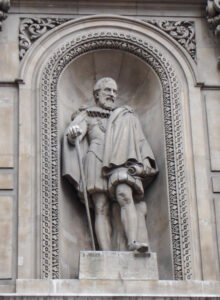Should you find yourself perambulating around the perimeter of the Royal
Exchange, you might chance to gaze up at the two imposing statues set into the
north side of the Royal Exchange (that’s the side directly facing the Bank of
England). Occupying the niche on the right is London’s most famous medieval
Lord Mayor – Richard Whittington. While on the left, stands the less well
known 17 th century entrepreneur Hugh Myddelton, the driving force behind the
construction of the New River, an ambitious engineering project to bring clean
water into London.
Water, water everywhere…
In the early 17th century, London was a city on the rise— but while the
population boomed, its infrastructure lagged far behind and access to clean,
reliable water was one of the greatest concerns.
Most people relied on local wells, the River Thames, or the medieval public
conduits to collect water. These sources were often dirty, unreliable, and
disease-ridden. The idea of piped water was still novel and limited to the
wealthy, who could afford private supply systems using wooden pipes and
waterwheels.
A revolutionary solution
Recognising the city’s desperate need for a better water supply, the authorities
began to consider more ambitious solutions. The most promising idea came
from wealthy landowner Edmund Colthurst, who proposed diverting fresh
water from springs 40 miles away in Hertfordshire to London. Work began in
1604, but financial and technical problems soon halted the project.
Enter Hugh Myddelton: Visionary and Financier
The man who would ultimately make the New River a reality was Sir Hugh
Myddelton, a Welsh goldsmith, entrepreneur, and Member of Parliament. In
1609, Myddelton took over the struggling scheme from Colthurst and poured
his own money into it.
As well as the technical challenges of the project, Myddelton had to face
objections from owners of the land he needed to cross, and he soon ran out of
money to pay them off. Luckily King James I stepped in and financed half of
the costs in return for half of the profits, effectively becoming a partner in the
project.
How the River flowed…
The plan involved constructing a 38-mile-long artificial channel from the
springs at Chadwell and Amwell in Hertfordshire to a reservoir in north
London, known as the New River Head in Islington.
Water was not pressurised as in modern systems but flowed by gravity from the
higher ground of Hertfordshire down into the city. It was carefully engineered to
descend only a few inches per mile—slow enough to avoid erosion, but fast
enough to maintain a consistent flow.
It took a rambling route following the contours of the terrain, and then, from the
reservoir in Islington it was to be delivered to city properties in hollowed out
elm logs.
A Utility Pioneer
The New River officially opened in 1613. To manage this new water supply,
The New River Company was established in 1619, making it one of the earliest
examples of a joint-stock utility company.
Investors—many of them wealthy London merchants—were granted shares in
return for funding the system’s maintenance and expansion. The Company soon
acquired legal powers to lay pipes, charge customers, and maintain water
infrastructure.
Customers who wanted a water supply had to pay a subscription fee, after which
the company would connect their property to the main line.
The service was far from round-the-clock, however. Water was delivered on a
rotating schedule, often for just a few hours a day. A company ‘turncock’
(named after the valves they turned) would control the water flow to different
districts or properties by opening and closing valves at set times.
Water was measured not by volume, but by pipe size. The amount paid by the
customer was based on the diameter of the pipe feeding their premises – larger
households or businesses paid more for thicker pipes and greater flow.
If a customer failed to pay their fees, there were consequences, disconnection
being the most effective. To deter tampering, the New River Company also
employed inspectors to check for illegal connections or attempts to access water
after being disconnected. People caught doing so could be fined or even
prosecuted.
Legacy and Longevity
The New River Company operated for over 250 years, during which time it
expanded its network, introduced new technologies (such as iron pipes), and
became a key part of London’s infrastructure. It remained a private company
until 1904, when its water supply functions were taken over by the
Metropolitan Water Board, which later became part of Thames Water.
Today, much of the New River still exists. While parts of the original channel
have been covered or rerouted, sections remain visible and are maintained as
walking trails such as the New River Path and heritage sites.
Hugh Myddelton was recognised for his efforts in 1622 when the King made
him a Baronet. His statue can also be seen today on the corner of Islington
Green, near the site of the original terminus of

